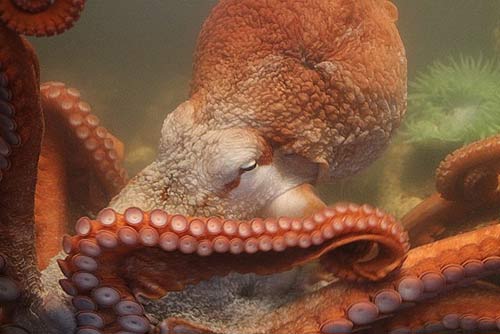Oregon Coast Scientists' Discovery: Mariana Trench is Noisy
Published 03/02/2016 at 4:01 PM PDT
By Oregon Coast Beach Connection staff

(Newport, Oregon) – A group of researchers – mostly from the Oregon coast area – recently spent a considerable amount of time far from these shores and deeper than most have ever gone. The band of explorers eavesdropped on the famed Mariana Trench, near Micronesia, discovering a cacophony of noises down some 36,000 feet – about seven miles. (Photo: researchers deploy the hydrophone into the trench).
What surprised them was the mish-mash of both natural and man-made sounds, when they expected to hear nearly nothing. Everything from ship traffic, whales to even earthquakes was heard, using a a titanium-encased hydrophone.
The researchers were from Oregon State University, the National Oceanic and Atmospheric Administration and the U.S. Guard, including some connected with the Hatfield Marine Science Center in Newport. For three weeks, the group plunged the hydrophone into the trough known as Challenger Deep, in a project designed to establish a baseline for ambient noise in the deepest parts of the Pacific Ocean. Scientists wanted to know more about human-caused noise down below and if that was growing.
 Instead they found a rich sound environment created by nature as well. Robert Dziak, a NOAA research oceanographer and chief scientist on the project, said they thought a place so deep would be nearly silent. Yet they heard the sounds of earthquakes creaking and rumbling close by and far away. Whales moaned and sang. Then a category 4 typhoon created an “overwhelming clamor” overhead. Ship traffic and their propellers made their presence known as well.
Instead they found a rich sound environment created by nature as well. Robert Dziak, a NOAA research oceanographer and chief scientist on the project, said they thought a place so deep would be nearly silent. Yet they heard the sounds of earthquakes creaking and rumbling close by and far away. Whales moaned and sang. Then a category 4 typhoon created an “overwhelming clamor” overhead. Ship traffic and their propellers made their presence known as well.
Dziak's group recorded a loud magnitude 5.0 earthquake that happened about six miles down, at a point where the hydrophone was actually slightly lower than the quake itself.
“The sound of the typhoon was also dramatic, although the cacophony from big storms tends to be spread out and elevates the overall noise for a period of days,” Dziak said.
Oregon-based ocean engineer Haru Matsumoto said getting these initial recordings was not easy. Pressures at the depth of seven miles are incredible, and NOAA's Chris Meinig had to help develop a device that could survive that.
“It is akin to sending a deep-space probe to the outer solar system,” Dziak said. “We’re sending out a deep-ocean probe to the unknown reaches of inner space.”
OSU's Joe Haxel will lead another return to Challenger Deep in 2017, where the researchers will deploy the hydrophone for a longer period of time and attach a deep-ocean camera.
Dziak, Matsumoto and Haxel are affiliated with the Acoustics Program in the NOAA/Pacific Marine Environmental Laboratory and work at OSU’s Hatfield Marine Science Center in Newport. The project in Challenger Deep is one of a number of projects in which the U.S. Coast Guard partners with NOAA to sponsor scientific research. More about Oregon Coast Science. Oregon Coast Lodgings for this - Where to eat - Maps and Virtual Tours

More on the Hatfield and Newport below:




More About Oregon Coast hotels, lodging.....
More About Oregon Coast Restaurants, Dining.....
Cannon Beach Lodging
Nehalem Bay Lodgings
Manzanita Hotels, Lodging
Three Capes Lodging
Pacific City Hotels, Lodging
Lincoln City Lodging
Depoe Bay Lodging
Newport Lodging
Waldport Lodging
Yachats Lodging
Oregon Coast Vacation Rentals
Oregon Coast Lodging Specials
LATEST Related Oregon Coast Articles
Likely just before dawn best hour but peak happens during daylight. Weather
Dark Sky Week is Prime Along Oregon Coast: Where and Where Not to Go
General guide to dark sky viewing from south to north coast. Astronomy
Sizable Price Drop, Deals in Lincoln City During Quiet of April on Central Or...
20 perc off at A1 Vacation Rentals across its roster, including Gleneden Beach. Lincoln City specials
Upcoming S. Oregon Coast Events Include Gem Show, History: Coos Bay, Bandon
May 6 talk at Coos History Museum, Mayfly Fest May 17, Bandon Rock / Gem Show June 7,8
Washington Coast Cleanup on April 19 - Coinciding with Oregon Coast's SOLVE E...
From the Puget Sound to Long Beach, alongside Oregon's cleanup. Washington coast events, Seaside events
Astoria's Riverwalk Gets New Lighting, More N. Oregon Coast Roadwork
Delays coming this summer, but the riverwalk has a new look. Seaside, Cannn Beach
April Gets Even Cheaper Midweek at Depoe Bay, Lincoln City: Oregon Coast Deals
Off-season rates plus more at Keystone Vacation Rentals. Depoe Bay lodging specials, Lincoln City hotel reviews, Newport hotel reviews
Washington Coast Begins Week of Clam Digs, April 12 Through 18
Long Beach, Twin Harbors, Mocrocks and Copalis at different times. Washington coast events
Back to Oregon Coast
Contact Advertise on BeachConnection.net
All Content, unless otherwise attributed, copyright BeachConnection.net Unauthorized use or publication is not permitted














































